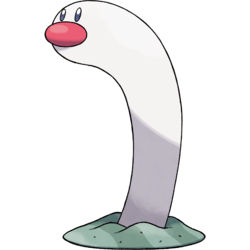From Bulbapedia, the community-driven Pokémon encyclopedia.
|
|
| Line 47: |
Line 47: |
| Wiglett is a long, white {{OBP|Pokémon|species}} that seems to be perpetually buried within the earth, leaving only its head and part of its body visible. It has beady black eyes and a large, round, pink nose. Although Wiglett has a stated Pokédex height, it is unknown how long it really is underneath the sand, or what the rest of its body looks like.<ref name=SVsite/> | | Wiglett is a long, white {{OBP|Pokémon|species}} that seems to be perpetually buried within the earth, leaving only its head and part of its body visible. It has beady black eyes and a large, round, pink nose. Although Wiglett has a stated Pokédex height, it is unknown how long it really is underneath the sand, or what the rest of its body looks like.<ref name=SVsite/> |
|
| |
|
| Wiglett heavily resembles {{p|Diglett}}, to the point where some researchers initially confused it for a [[Paldea]]n [[regional form]] of Diglett. However, this physical resemblance is coincidental; Wiglett and Diglett otherwise differ entirely in habitat and diet. It is said that the two species ended up having similar body plans as an adaptation to better suit their environments and their burrowing behavior. Wiglett lives in beaches and seas, where it burrows into beach sand.<ref name=WPES /><ref name=WPESvideo /> It pokes part of its body out of the ground to feed.<ref name=SVsite />
| | Wiglett lives in beaches and seas, where it burrows into beach sand.<ref name=WPES /><ref name=WPESvideo /> It pokes part of its body out of the ground to feed.<ref name=SVsite /> |
|
| |
|
| Wiglett has an exceptional sense of smell, which has a range of over 60 feet (20 meters). Wiglett is a timid and cautious Pokémon; it hides in the sand when it picks up the scents of other Pokémon nearby.<ref name=SVsite>[https://scarletviolet.pokemon.com/en-us/pokemon/wiglett/ Wiglett — Pokémon Scarlet and Pokémon Violet Official Website]</ref><!-- | | Wiglett has an exceptional sense of smell, which has a range of over 60 feet (20 meters). Wiglett is a timid and cautious Pokémon; it hides in the sand when it picks up the scents of other Pokémon nearby.<ref name=SVsite>[https://scarletviolet.pokemon.com/en-us/pokemon/wiglett/ Wiglett — Pokémon Scarlet and Pokémon Violet Official Website]</ref> |
| | |
| | Some researchers confused Wiglett for a [[regional form]] of {{p|Diglett}} due to their resemblance, but they are separate species and differ in habitat and diet. It is theorized that the two species ended up having similar body plans as an adaptation to suit their environments and their burrowing behavior.<!-- |
|
| |
|
| ==In the anime== | | ==In the anime== |
Revision as of 00:15, 30 September 2022

|
The subject of this article is a Pokémon which has recently been announced.
This article's contents will change as more information becomes available, perhaps abruptly. Please be cautious when adding information to this article, as rumors and speculation can often be confused with facts. Avoid any information on this subject which is not confirmed by reliable sources.
|
Wiglett (Japanese: ウミディグダ Umidiguda) is a Water-type Pokémon introduced in Generation IX.
It is not known to evolve into or from any other Pokémon.
Biology
Wiglett is a long, white Pokémon that seems to be perpetually buried within the earth, leaving only its head and part of its body visible. It has beady black eyes and a large, round, pink nose. Although Wiglett has a stated Pokédex height, it is unknown how long it really is underneath the sand, or what the rest of its body looks like.[1]
Wiglett lives in beaches and seas, where it burrows into beach sand.[2][3] It pokes part of its body out of the ground to feed.[1]
Wiglett has an exceptional sense of smell, which has a range of over 60 feet (20 meters). Wiglett is a timid and cautious Pokémon; it hides in the sand when it picks up the scents of other Pokémon nearby.[1]
Some researchers confused Wiglett for a regional form of Diglett due to their resemblance, but they are separate species and differ in habitat and diet. It is theorized that the two species ended up having similar body plans as an adaptation to suit their environments and their burrowing behavior.
Trivia
- Wiglett was revealed on September 28, 2022, on a mock seminar titled "World Pokémon Ecological Society".[2][3]
Origin
Wiglett appears to be based on garden eels. The fact that it physically resembles Diglett may be a reference to convergent evolution or parallel evolution, which can lead to separate organisms independently developing similar or identical characteristics and body plans. This may also be a reference to a species complex, in the sense that they are unrelated organisms that could be erroneously identified as a single species due to shared characteristics.
Name origin
Wiglett may be a combination of wiggle, water, and Diglett.
Umidiguda may be a combination of 海 umi (sea) and ディグダ Digda (Diglett).
In other languages
| Language
|
Title
|
Meaning
|
 Japanese Japanese
|
ウミディグダ Umidiguda
|
From 海 umi and ディグダ Digda
|
 French French
|
Taupikeau
|
From Taupiqueur and eau
|
 Spanish Spanish
|
Wiglett
|
Same as English name
|
 German German
|
Schligda
|
From Schlick and Digda
|
 Italian Italian
|
Wiglett
|
Same as English name
|
 Korean Korean
|
바다그다 Badageuda
|
From 바다 bada and 디그다 Digda
|
 Mandarin Chinese Mandarin Chinese
|
海地鼠 Hǎidìshǔ
|
From 海 hǎi and 地鼠 Dìshǔ
|
 Cantonese Chinese Cantonese Chinese
|
海地鼠 Hóideihsyú
|
From 海 hói and 地鼠 Deihsyú
|
|
|
|
|
|
|
|
Related articles
Notes
External links


